How To Improve MPG's
There is a lot of people now that are feeling the pinch from the fuel station when your seeing $5.00 a gallon and higher prices for fuel. But there is several things you can do to gain a bit of a edge and and make it affordable to continue with life. The biggest factor is speed if you slow down a Dodge Cummins gets better MPG hands down every time.
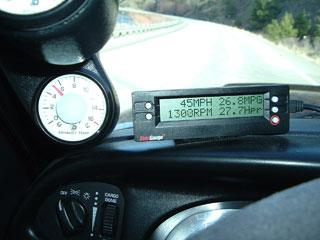
|
45 MPH Statistics ScanGauge II Display Speed .................................... 45 MPH RPM's..................................... 1,308 RPM's MPG's..................................... 26.8 MPG Horsepower ........................... 27.7 HP (At flywheel) GPH......................................... 1.67 Gallons Per Hour A-Pillar Gauges Boost....................................... 0 PSI Pyrometer............................... ~500*F |
||||||||||||||||||||||||||||||
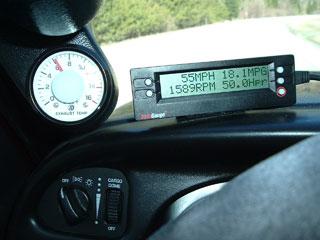
|
55 MPH Statistics ScanGauge II Display Speed .................................... 55 MPH RPM's..................................... 1,589 RPM's MPG's..................................... 18.1 MPG Horsepower ........................... 50.0 HP (At flywheel) GPH......................................... 3.03 Gallons Per Hour A-Pillar Gauges Boost....................................... 2 PSI Pyrometer............................... ~600*F |
||||||||||||||||||||||||||||||
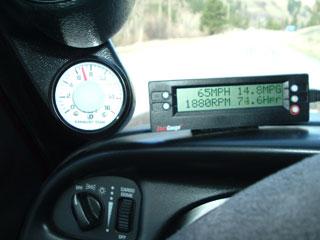
|
65 MPH Statistics
Efficiency of a Dodge Cummins is related direct to pyrometer temps and GPH. Basically the faster you travel or the more drag you put on a engine you must compensate by adding more fuel to keep the speed constant. So this is why you see a increase in pyrometer temp on a hill or when your towing. But at the same time the GPH rises as well during these loads as seen above. But to so you math to calculate MPG from speed and GPH will shock you.
Mile Per Gallon Calucation
Gallons Per Hour Calculation
Speed Calculation Now we will use the examples above to calculate MPG form fuel flow and speed. 65 MPH / 4.39 GPH = 14.80 MPG So since Pyrometer is a direct connection with fuel usage it only makes since to try and reduce you Pyrometer temps as much as possible which in turn reduces fuel usage. A rule of thumb I created that will hit 20+ MPG every time is.. Mopar1973Man's Notes:Keep your pyrometer under 600°F and keep you boost pressure under 5 PSI. As seen above with the 45 MPH and 55 MPH speed the drag or load was reduced by slowing down. As seen in pyrometer temperatures, horsepower produced, reduction in fuel usage, etc. These effect the MPG number directly. Like in the 65 MPH its consuming 4.39 GPH but now looking at 55 MPH at 3.03 GPH and 45 MPH at 1.67 GPH. That a huge reduction in fuel usage. Speed And TimeA lot of people are telling my fables of... "I get better MPG numbers at 70-75 MPH than at 55-60 MPH". This is untrue and unproven. Normally this is said because of the factor of time. Most people are in a hurry. Well I'm going to show difference in time and speed. 10 Mile Trip
100 Mile Trip
1,000 Mile Trip
Efficient Driving BehaviorExcessive speed decreases fuel economy. In addition, excessive idling, operating the vehicle in the wrong gear and accelerating and decelerating rapidly all consume extra fuel. It has been estimated that proper driving technique can account for a 30% variation in fuel economy. The following is a short list of behaviors exhibited by those drivers that consistently obtain good fuel economy. Simple behaviors, like coasting to a stop instead of staying on the accelerator until the last minute and then braking hard, add up to significant fuel savings after thousands of miles.
1. High average vehicle speeds with minimum time spent at maximum vehicle speed Vehicle Speed ManagementThe keys to managing the vehicle’s road speeds involve maintaining the lowest reasonable cruise speeds possible and minimizing time spent at maximum vehicle road speeds. The vehicle’s road speed has a tremendous effect on fuel economy. As road speed increases, so does air resistance and rolling resistance (to a certain extent). Thus, the power required to move the vehicle down the road increases. For example, at 55 mph, you may get 23 mpg; at 65 mph, you'll get 18 mpg; and at 70 mph, you'll get only 16 mpg. Anticipating ChangeThe key to effective cruise operation is anticipating changes that may occur while driving on the open road. Maintaining a high field of vision and establishing proper following distances is a good start. Drivers should also do the following:
1. Anticipate changes in traffic and road conditions Cruise Control OperationCruise control can be a great equalizer. While some of the very best drivers may still be able to obtain better fuel economy without using the cruise control, cruise control in general can make every driver better than average. UPDATE! July 18, 2008 - Mopar1973Man's Notes... Here is a few tips I found in my travels that work every time. 1. If you know the road conditions like narrow windy roads. Don't try and travel the road at speed limit. Back down to a speed that you can set your cruise control for and never cancel it. If you must hit the brakes for a corner you traveling to fast any ways. Being that every time you decelerate for a corner then accelerate back to speed you can loss up to 0.1 to 0.2 MPG fro every time you do it. 2. When traffic permits try driving slower or take back roads to reduce speed. Like here in Idaho there is no minimum speed limit law. So your permitted to drive as slow as you wish. The only laws we have is if we are holding more than 3 vehicles we must pull over and allow traffic to pass. 3. In city traffic try to find a travel plan that allows you to travel with the least amount of stops. Also try to avoid heavy traffic that might leave you idling for long periods.
Rock-Solid Rule Shifting TechniquesProper operating techniques result in the lowest number of engine revolutions per mile to maximize mpg. Constant operation below 1600 rpm significantly reduces fuel consumption. Follow two general rules:
1. Maximize the percentage of time in top gear.
Rock-Solid Rule
Rock-Solid Rule Operation in Hilly and Mountainous TerrainIn rolling terrain, use a light throttle and allow momentum to carry the vehicle over short grades. In hilly and mountainous terrain, where possible, use the engine’s entire operating range before gearing down. When cresting steep grades, use gravity to bring the vehicle back to the desired cruise speed. Vehicle Power RequirementsIn the simplest of terms, you burn fuel to make horsepower, and you use horsepower to overcome all of the forces that are trying to retard or hold back the truck. So, a truck that rolls down the road with minimum drag will use less horsepower and consume less fuel. The power required to maintain a given road speed depends on the sum of the following forces:
1. Aerodynamic Drag Mopar1973Man's Notes: Oversized tires have a higher rolling resistance than smaller tires. Also street radial tires have less rolling resistance that a off-road tire. Aerodynamic DragAerodynamic drag is the result of forces (pressure imbalances) acting on a vehicle as it passes through the air. The magnitude of the forces acting on a vehicle depends on speed, frontal area and external shape. Aerodynamic drag is the most significant contributor to vehicle power requirements above a speed of 50 mph. As the following graph shows, aerodynamic aids can have a major impact on vehicle fuel economy on an interstate duty cycle and very little impact on an intercity duty cycle.
Rock-Solid Rule Mopar1973Man's Notes: Lift kits that raise the body of the truck higher greatly increase the aerodynamic drag! Tire Rolling ResistanceRolling resistance results from the internal friction of a tire as it deflects (flexes) during motion. Energy spent generating heat in the tires is energy that does not contribute to moving the vehicle. Cooler running tires are more fuel-efficient than tires that run hotter. Complex rubber compounds, advanced casing construction and enhanced tread designs have led to new standards in tire performance. Tire rolling resistance is the second most significant contributor to vehicle power requirements. Tire rolling resistance is influenced by multiple factors:
1. Vehicle Speed Rolling resistance is the second largest consumer of power on a truck. The type of tire, size, width and tread design have a sizeable effect on fuel economy and performance. Fuel efficient tires have demonstrated gains as high as 2-3 mpg. Tread Depth and PatternAccording to Bridgestone, the tire tread accounts for 60–70% of the tires’ rolling resistance. Not only do the tires differ in rolling resistance when new, but as the tread wears, the rolling resistance of the tire changes. A 7/32 tread wear represents ~10% reduction in rolling resistance (5% better mpg) compared to a new tire. Rib tires at all wheel positions will provide greatest fuel efficiency. Tread pattern is important because lugs have deeper tread (more rolling resistance) than ribs. If we take a new ribbed tire as the standard, a new lugged tire is less fuel efficient by about 6%. A worn tire is about 7% more fuel efficient than a new tire. UPDATE! July 18, 2008 - Mopar1973Man's Notes... Here is some pictures to look at...
Surprisingly... In the first picture the Michelin LTX gain me +3 MPG roughly because of tread face is smoother and the tire weight is nearly 20 pounds less. This reduces rotational mass and rolling resistance. Then when you look at the difference in the second picture the Big O XT will beat the Cooper STT hands down because it even lighter than the Michelin LTX but the tread face area is reduced. I've found that most all 235/85 R16 tires tend to be of a load range E design. As you can see in the 3rd picture the width of the tire is reduced but the radius is basically the same... So lighter tires with a smooth tread pattern save more fuel than heavier tire with a aggressive pattern... Tire Inflation PressureProper inflation pressures critically affect tire performance. Underinflation can detrimentally affect tire performance and durability. Specifically, it:
1. Reduces fuel economy Mopar1973Man's Notes: Over inflation will not improve MPG much more. But it will wear the centers out of the tread face quickly. Intake and Exhaust RestrictionAn engine that is starved for air (intake restriction) or unable to expel exhaust (exhaust restriction) will lack power and waste fuel. The extra fuel burns inefficiently at best because it takes air to completely oxidize the fuel and extract all of the power that it contains. Mopar1973Man's Notes: BHAF and Straight Piped Exhaust as really good way to gain MPG's! Engine Operating Temperature (Coolant and Lube Oil)Low coolant temperatures indicate an engine that is too cold for efficient combustion. Fuel liquefies on the cold cylinder walls and fails to burn. Of course, excess heat causes engine failure. Lube oil below the ideal temperature is more viscous and harder to pump. Oil above the ideal temperature is too thin to lubricate properly. Either way, the engine suffers.
Coolant and lube oil operating temperatures can contribute greatly to fuel efficiency. Typical cooling system operating temperatures are above 180°F. A 0.4% fuel economy loss is associated with every 30°F decrease in temperature. LubricantsWhile the efficiency of drivetrain components is largely fixed by design, gross efficiency losses can be minimized through proper selection of lubricants. Synthetic base lubricants are manufactured in the laboratory to exhibit superior high temperature stability and low temperature fluidity. Since these fluids are created to exhibit less thickening at low temperatures, pumping losses are reduced and substantial reductions in spin losses can be realized at low operating temperatures. Test results indicate no significant difference in engine efficiency between synthetic and mineral base lube oils at normal operating temperatures. Since the synthetics are more expensive and, in an engine crankcase, are subject to the same contaminants as mineral based oils, they may not be cost effective. All oils thicken at low temperature, causing increased fuel consumption. The synthetic oil is less affected by temperature. This makes synthetic oils more fuel efficient at lower ambient temperatures.
Driveline Components The high temperature stability and low temperature fluidity of synthetic lubricants make them ideally suited for drivetrain components. In this environment the lubricant is not subjected to combustion byproducts. This means the lubricant, with its higher oxidation resistance can last substantially longer. Drain intervals of 50,000 to 100,000 miles more than offset the higher purchase price of the lubricant. Dynamometer and on-highway vehicle testing have demonstrated significant benefits in fuel economy.
Weather and Seasonal ConditionsYou can’t control the weather or the seasons, but they definitely affect your fuel economy. Running only on sunny days with moderate temperatures is very impractical, but you have to take the weather and seasonal variations into account when checking fuel economy. Ambient Temperature Air becomes more dense as temperatures drop, which increases air resistance. For every 10° F drop in temperature, aerodynamic drag increases by 2%. Thus, fuel efficiency will drop by 1%. Overall, fuel economy tends to be higher in the summer than the winter. According to North American Truckload Fleet Data, driving in the summer increases fuel mileage by 8 to 12% over driving in the winter months. Temperature also affects the tires’ inflation pressure. Tire inflation tends to fall when the temperature drops. Running tires low on air pressure in hot weather is more of a safety issue than a fuel economy problem. And heat is the tire’s worst enemy. For safety and economy, check inflation pressures frequently with an accurate tire gauge. When seasons change and temperatures fluctuate, increase the frequency of inflation pressure checks. Wind Headwinds and crosswinds can significantly increase aerodynamic drag and reduce fuel efficiency. For every 10 mph of headwind or crosswind, mpg is reduced by nearly 13%.You cannot cheat increasing wind resistance. Rain and Snow Precipitation such as rain or snow increases rolling resistance because the tires must push their way through the water, slush or snow on the pavement. Also, water is a more effective coolant than air, so the tires, transmission lubricant and axle lubricant operate at cooler (less efficient) temperatures. Rolling resistance and drivetrain friction in light rain increase fuel consumption by 0.2 to 0.3 mpg, per SAE testing. Fuel Blends While blended fuels provide better startability and protection against fuel gelling than standard #2 diesel, fuel efficiency decreases. “Summer” fuel improves mileage up to 3% more than “winter” fuel. Mopar1973Man's Notes: Most Fuel additives, injector cleaner, cetane boosters, high cetane fuels and anti-gel greatly reduce the BTU value of the fuel. 2 Cycle Oil is one of the few additives with a high BTU content. Also winterized diesel fuel has a considerable loss in BTU's over summer fuels. Here is a graphic display of pyrometer temps versus MPG's. These are rough measurements and will vary from truck to truck. But it is a good guideline. UPDATE! June 2, 2009 - IAT (Intake Air Temperature) RelationshipMopar1973Man's Notes: I've found that IAT temperature has a direct bearing on MPG numbers. My findings point out that warmer IAT temperature will produce better MPG number versus colder temperatures. Once the IAT temperature rises above 100*F or about 60*F outside temperature you'll see radical change in MPG's. The reason being is that colder air is more dense and requires more fuel to keep the balance but producing more HP/TQ but reverse this and warm the intake air and the air is less dense requiring less fuel to burn, also burning easier because the air is pre-heated and easily reaches the auto-ignition temperature. Then the colder the air is the more wind drag you have at speed. Warmer the air the less wind drag you have so this is part of the reason why summer MPG's are better. |



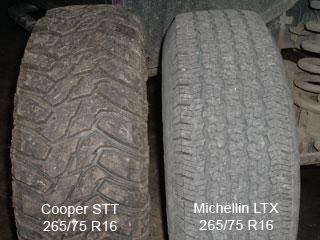
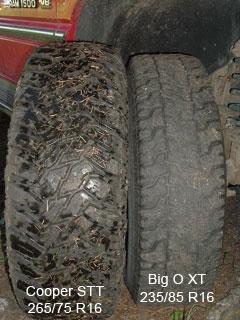
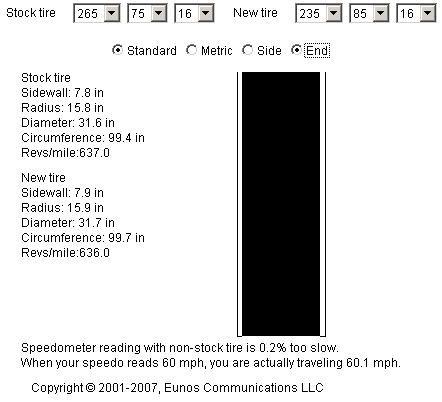
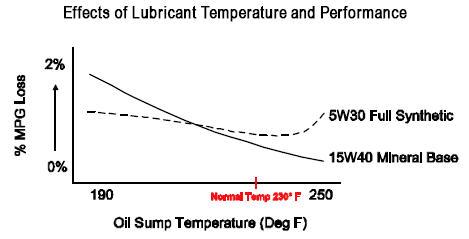
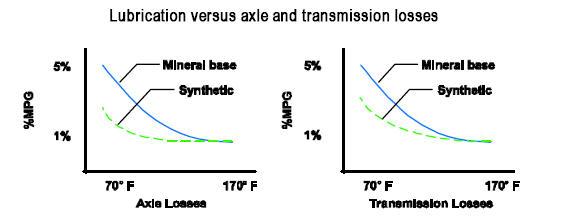

There are no reviews to display.